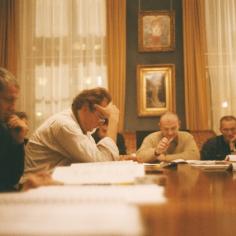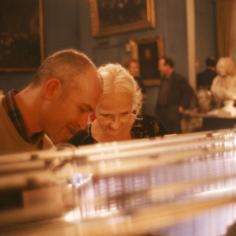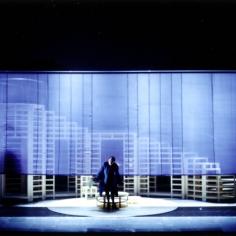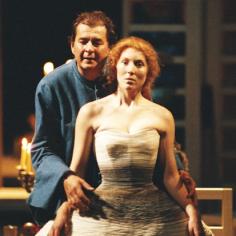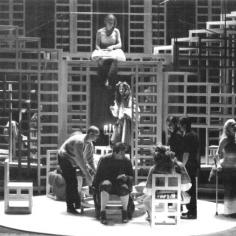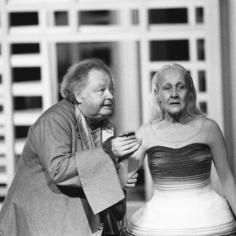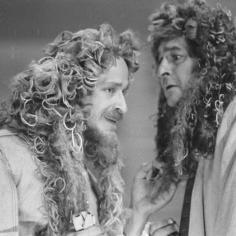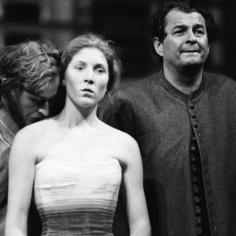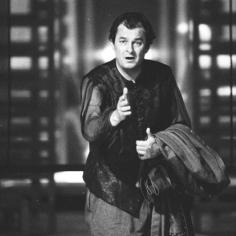1999 · L’École des femmes · Molière · Vigner (EN)
September 1999 Vigner was for the second time invited to the Comédie-Française, this time to direct MOLIERE’s L'ÉCOLE DES FEMMES, with CATHERINE SAMIE, IGOR TYCZKA, ÉRIC RUF, BRUNO RAFFAELLI, LAURENT REY, ROGER MOLLIEN, JEAN-CLAUDE DROUOT, JACQUES POIX-TERRIER, JOHANNA KORTHALS-ALTÈS and the musicians VINCENT THOMAS, SÉBASTIEN SUREL, CHRISTINE FONLUPT, opening the season at Salle Richelieu. He drew on the talent of great actors in the ensemble of the Comédie-Française, with some of whom he had worked before: BRUNO RAFFAELLI for REVIENS À TOI (ENCORE), ERIC RUF for BAJAZET.
"Playing a scene is first and foremost speaking it."
LOUIS JOUVET
Molière’s eighth play, L'ÉCOLE DES FEMMES, is his first original five-act verse comedy. It was first performed at the Théâtre du Palais-Royal in 1662 and met with mixed reactions. It gave rise to polemics that are still known today as the School of Wives dispute. Its latest production at the Comédie-Française dated back to 1983. Vigner comes up with project that involves hard and strenuous work, and an unusual interpretation of Molière’s text.
"Bernard Noël, in a meeting with his public, admitted that he was extremely pessimistic and added, ‘if there is anything that can save the world, it is diction …’. Lacan’s texts about L'École des femmes are among the finest I’ve ever read. He says that L'École des femmes is the manifesto of classical comedy at its best, and adds that romantic theatre - Victor Hugo - is the death of classical comedy. I have just directed Marion de Lorme, which is set in the 17th century, the time when classical theatre was born … with Corneille the father of classical tragedy. L'École des femmes made Molière the master of classical comedy. It was this difference in artistic and political position that gave rise to the legendary conflict regarding L'École des femmes. Racine owed everything to Molière, but he wrote perfect theatre - together they form an equilateral triangle. There is no such thing as perfection. Molière’s theatre combines intelligence, constructive genius and emotions. And that is what the story of Arnolphe is all about, and the reason why he resigns at the end of the play. Arnolphe is a 17th-century humanist, making the human being the centre of the universe. He even ends up giving Agnès, his very own creation, to the young Horace. Having made Agnès a woman, he also turns Horace into a man. He has carried his project to its end and withdraws. Molière does with Racine what Arnolphe does with Horace. And Horace is not given to sentiment. Perhaps he is better at telling stories, but he has no heart. He foreshadows Don Juan. Soon, Agnès will become Célimène. L'École des femmes is a matrix, a womb that contains the whole of Molière’s œuvre."
EV
"Each man has his own design
For wedding bliss, and I shall follow mine.
I'm rich, and so can take a wife who'll be
Dependent, in the least respect, on me -
A sweet, submissive girl who cannot claim
To have brought me riches or ancient name.
The gentle, meek expression which she wore
Endeared Agnès to me when she was four;" says Arnolphe [1]
"This is where everything starts. The initial moment is love. Arnolphe encounters love for the first time, on that day thirteen years ago, in the person of one little girl among a bevy of others; and this new feeling - unknown to him until then -, this overwhelming experience lays the foundation for an architecture he builds in his dream - a city, laws and rules, a school… Arnolphe’s vision is a personal one, a highly individual Utopia which is exemplary in nature. Arnolphe has brought Agnès up away from the world, in a closed world, on the philosophical principle ‘I think, therefore I am’ to prepare her for the freedom of being. He loves Agnès as God loves his creation. Agnès loves Arnolphe as a daughter loves her father. Horace, on the other hand, represents the outside world; when he enters that enclosed space he causes it to break open: desire is born, love changes its nature. Arnolphe no longer sees Agnès as a child in a Utopian vision but as a woman. This is the paradox in Arnolphe: just because his plan is a complete success, it is bound to fail completely - he cannot marry the woman he has created. In order to give his work perpetuity in the real world, he gives this woman in marriage to Horace. Agnès brings him back to the real world. As Agnès becomes a woman, Arnolphe, the Creator God, the master, turns into a man. We witness the birth of a man."
EV
ARNOLPHE
Come, come, my pretty child,
You who are so intractable and wild.
here is your gallant : perhaps he should receive
A little curtsey from you, as you leave.
(To Horace:)
Farewell : your sweet hopes seem to have turned to gall;
But love, my boy, can't always conquer all.
AGNES
Horace ! Will you let him take me away from you ?
HORACE
I'm dazed with grief, and don't know what to do.
ARNOLPHE
Come, chatterbox.
AGNES
No. Here I shall remain. [2]
"Eric Vigner’s mise en scène strips a text naked by seeking out the internal punctuation of the language which puts the body in motion, and introduces, in the guise of a comedy, the ways and byways of childhood and love. With the pace set by a musical trio, here we are confronted with a Molière whose shades of tone grow out of a fascinating mix, a fusion of speech and listening."
JEAN CHOLLET, ACTUALITÉ DE LA SCÉNOGRAPHIE, october 1999
"L’essentiel dans le travail de Vigner est dans sa capacité à faire écouter non seulement Molière, mais son écho."
RenÉ Solis (LibÉration, le 30 septembre 1999)
Between 1993 and 1999, Eric Vigner designs his stage sets in cooperation with the scenographer Claude Chestier. From 2000 onwards, Vigner returns to his early love, visual art, and confirms his ability to deal with space.
© Photography : Alain Fonteray
Texts assembled by Jutta Johanna Weiss
Translation from the French by Herbert Kaiser
© CDDB-Théâtre de Lorient
